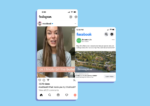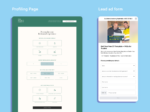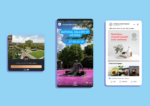BLOG
Why You Should Use Meta for Your Property Marketing
Digital advertising plays an important role in your marketing campaigns. Social platforms in particular allow you to reach a range of audiences and tell your unique brand story in different ways. Georgia Worswick is a Senior Campaign Manager at Social Garden. She has 4 years of experience working across various Meta platforms. Keep reading to follow our discussion on Meta and how you can use it in your property advertising to achieve great results.
What is Meta?
The word ‘meta’ has long been used in a digital context but in 2021 the term gained new meaning when the company formerly known as Facebook changed its name to Meta. Meta encompasses Facebook, Messenger, Instagram, Whatsapp and other technologies including the VR system Oculus, video-calling device Portal and digital wallet Novi. A large part of the rebrand was also for Meta to focus on bringing the “metaverse” to life.
What is the Metaverse?
A metaverse is a virtual space where users can come together via augmented reality, virtual reality, and cryptocurrency. The ‘Metaverse’ is a term coined to describe the digital ecosystem that exists across Meta’s suite of products, and how they can all work together to drive both organic and paid digital outcomes for businesses.
Why should you advertise on Meta’s platforms?
Here are just a few major reasons every brand needs to explore territories across Meta’s platforms:
- 82% of Australians use some form of social media at least once per day
- 77% of those social media users are on Facebook
- 58% are on Instagram
Meta’s products provide the opportunity to reach users at the beginning of their property journey (to make them aware of your offering and inform their later decision making) and also users who have previously engaged with your business (to drive key conversions and nurture prospects through each stage of the funnel).
The ability to ‘prospect’ to users on platforms like Facebook and Instagram is a key differentiating factor from Google, where users are explicitly expressing interest in your product or business. With Meta’s platforms, you can get in front of new audiences, leverage more creative formats to convey your key messages and understand what is resonating with potential buyers.
These users may end up converting through another channel (e.g. branded search) but the role that Facebook and Instagram play in driving awareness and traffic is a crucial part of any balanced paid advertising strategy.
What are Meta’s targeting options?
Meta’s powerful targeting functionality allows you to leverage first-party data along with detailed interest and demographic targeting in order to reach viable prospects across Facebook and Instagram.
These platforms frequently lead to sales for our clients and help to raise awareness of the development/building/brand in the local area.
By adding a Meta pixel to your website or landing page, you can:
- Observe how users interact with your site and build audiences for use in your advertising campaigns based on key actions such as page views, form submissions and downloads.
- Upload customer data or directly integrate it with your CRM to target users based on their stage in the sales funnel.
All actions users take across Meta platforms are also able to be used for audience creation – think Facebook and Instagram page engagement, Facebook event responses, video views and lead ad form submissions, which can all be used to help inform your targeting.
You can create high-quality audiences based on your customer and website data to create ‘lookalikes.’ A lookalike audience consists of prospecting users (no existing relationship with your brand) who exhibit similar behaviour, interests and/or demographic data to your source audience. This is a scalable and effective way to reach high-intent users, minimising wasted ad spend and maximising key metrics like click-through and conversion rates.
What is an exclusion list?
Just as important as who you target with your Meta advertising is who you don’t! Creating and excluding audiences based on lead submission and purchase data will ensure that you don’t waste valuable ad spend displaying ads to users who have already taken action. Anyone in the audiences you choose to exclude from your campaigns will be ineligible to see your ads.
Why should you use landing pages over lead ads?
While lead ad forms can be a high-converting lead capture tool, it’s worth keeping in mind that the quality of these leads will be less consistent than the data you collect through a landing page.
The low barrier to entry when completing a lead ad form (pre-filled data, no verification, little to no further information) often results in leads who are uncontactable (with a high likelihood of fake or incomplete data), unaware of what they have enquired about (or that they have enquired in the first place!), or uninterested.
Lead ads can drive a high volume of leads, but we’re firm believers in quality over quantity. Landing pages allow you to segment the conversion journey by audience and channel, aligning the content to things like product preferences or top performing creative.
Custom lead capture via landing pages can include elements like SMS verification (to ensure that leads are contactable) and qualifying questions (e.g. timeframe to purchase) to help your sales team identify hot leads and prioritise calls to increase your lead to sale rate.
What types of ad formats can I use across Meta?
Meta’s ad formats allow you to showcase your brand and split test different messaging to understand what drives both consideration and conversion.
Available formats include:
- Image (square/rectangle, text overlays, CTA overlays, floorplan overlays)
- Video (UGC, testimonials, product walkthroughs/display suite tours, animations)
- Collection ads (showcasing multiple home designs)
- Carousels (product or KSP based – clicks on each card can indicate user interest)
Utilising an array of formats and messaging not only helps you appeal to a wider range of prospective buyers, but can also provide insight as to what elements are resonating with each audience. These learnings can then be applied across your landing page, email marketing and even above the line advertising.
How can you keep up with advertising?
The Meta advertising landscape is constantly changing, and you should be constantly reviewing and updating your campaigns to keep up. A ‘set and forget’ approach is outdated on these platforms – here’s what you should be looking for:
Common problem #1
My audience or ads have a low click-through rate.
Solution
Presenting this message in this format isn’t resonating or of interest to your audience. Test out a different ad format and split test your messaging.
Common problem #2
My audience or ads have a high click-through rate but low conversion.
Solution
There may be a disconnect between the message in the ad and the messaging on your landing page. Review your CTAs and hero message across the page and ad suite.
Common problem #3
I’m seeing leads come outside my immediate catchment.
Solution
Check how campaign demographic data compares with lead data from other sources and whether this needs to be updated. See where your leads are coming from geographically and expand your geotargeting.
Summary
All of Meta’s platforms are valuable for businesses to tap into as part of a well-rounded marketing strategy. Setting up a Meta business page helps you build a community around your brand and connect with potential customers. We recommend diversifying your channel mix and tailoring this to the customer journey in order to make the most of each digital touchpoint.














